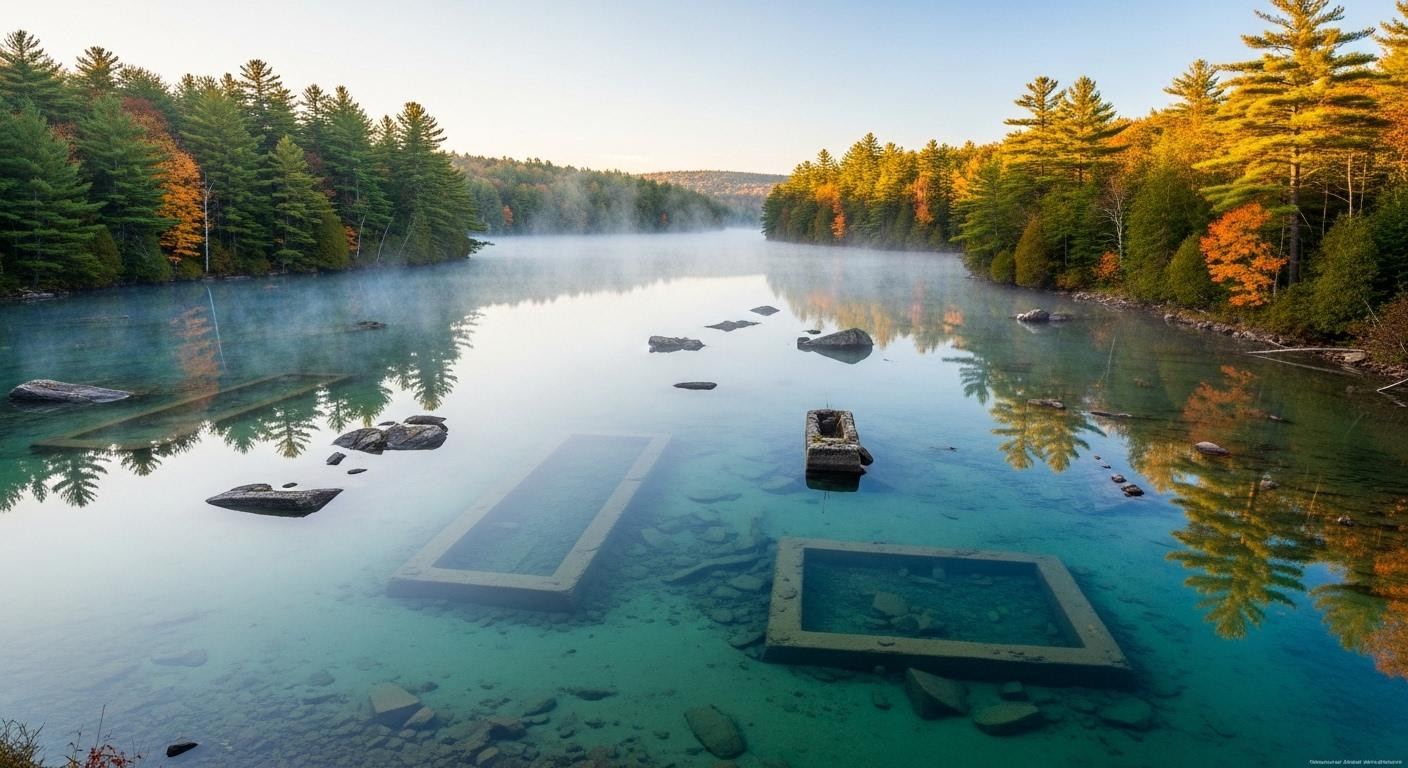Dawn breaks at 6:47 AM over Flagstaff Lake in western Maine. Morning mist rises from water that holds a secret beneath its mirror-calm surface. Roads, foundations, and memories of an entire village lie submerged 20 feet below. While millions queue at Alcatraz and tour Centralia’s industrial decay, fewer than 15,000 visitors annually discover this ghost town that emerges only when water levels drop, revealing stone outlines of a community deliberately erased in 1950.
The village that water claimed
Flagstaff Village disappeared beneath Maine’s largest man-made lake when the Long Falls Dam rose across the Dead River Valley. The flooding created 20,000 acres of water where 300 residents once farmed and logged. Central Maine Power systematically purchased land starting in 1930, clearing buildings by 1948, then burning remaining structures in 1949.
The village sat in Somerset County, 85 miles northwest of Portland and 5 miles from present-day Eustis. On July 4, 1949, residents held their final gathering called “Old Home Days.” Three hundred people attended this two-day celebration marking 100 years of community history before the waters rose.
Important buildings faced different fates. The schoolhouse was relocated to nearby Stratton. Churches and homes were either demolished or moved to higher ground. Families unable to reach financial agreements with the power company lost their homes entirely to rising waters, unlike preserved ghost towns that froze in time.
What emerges when the lake falls silent
When drought drops water levels by 10-15 feet, ghostly outlines appear through the blue. Grey concrete road fragments emerge like lost relics against the lake’s surface. Building foundations create rectangular shadows visible from kayaks and shoreline trails.
Ghostly outlines beneath blue water
Current water levels at 1140 feet reveal partial road networks during low-water periods typically occurring in late summer. Stone foundations of the general store and sawmill become visible when levels drop below 1135 feet. The contrast creates an otherworldly landscape where modern recreationists paddle directly over Main Street.
The final gathering of July 4, 1949
That last celebration drew former residents from across New England. Families gathered in the church for final services before demolition crews arrived. Even graveyards were relocated, with headstones moved to cemeteries in Eustis and Stratton. The methodical erasure took months, ensuring nothing would interfere with the rising reservoir.
Experiencing Flagstaff’s submerged memory
Visitors today explore this underwater ghost town through multiple sensory experiences. The peaceful water setting offers contemplative paddling over streets where children once played and farmers drove wagons to market.
Kayaking over lost streets
Canoe and kayak rentals cost $20-50 per day from outfitters in nearby towns. Morning paddling reveals the clearest views of submerged structures through calm water. Loons call across the 20,000-acre lake while paddlers glide directly above former doorsteps and garden plots.
Forest trails and morning light
Hiking trails circle the lake perimeter through pine and birch forests. The scent of resin and damp earth fills morning air during peak foliage season from mid-September to mid-October. Fall colors reflect perfectly on still water, creating doubled landscapes of red, orange, and gold.
The silence that draws visitors back
Unlike Centralia’s industrial ruins or Pripyat’s urban decay, Flagstaff offers natural integration of loss and beauty. The 520-square-mile drainage area maintains wilderness quiet broken only by wildlife sounds. Water temperature reaches comfortable 70°F in summer, inviting swimming above vanished homes.
Recent visitor surveys reveal emotional connections forming during contemplative experiences. The area sits at 1,200 feet elevation, providing cool relief during hot summers. Early morning visits before 8 AM offer the most profound solitude as mist rises from the lake surface.
Your questions about Flagstaff’s sunken village answered
When can you actually see the submerged structures?
Structures become visible when water levels drop below 1135 feet, typically during late summer drought periods. Current monitoring shows levels at 1140 feet as of October 2025. The best viewing occurs during September-October low-water seasons when road fragments and building foundations emerge through clear water.
What does it cost to visit this hidden Maine destination?
Lodging in nearby Eustis and Stratton ranges from $70-100 for basic motels to $100-180 for B&Bs. Meals average $12-25 at local establishments. Kayak rentals cost $20-50 daily with no admission fees for hiking or lake access, making it significantly more affordable than ticketed attractions like Alcatraz.
How does Flagstaff compare to famous ghost towns?
Flagstaff receives 10,000-15,000 annual visitors compared to hundreds of thousands at Centralia or restricted access at Pripyat. The underwater setting creates unique photographic opportunities impossible at land-based ruins. Visitors experience authentic solitude rather than tourist infrastructure, with camping and hiking as primary activities.
Steam rises from morning coffee on the empty shoreline at dawn. Beneath the water, roads lead nowhere and doorways open to fish instead of families. Above, only pine whispers and distant loon calls break the profound quiet. This ghost town exists between memory and mist, waiting for low water to reveal its secrets again.
